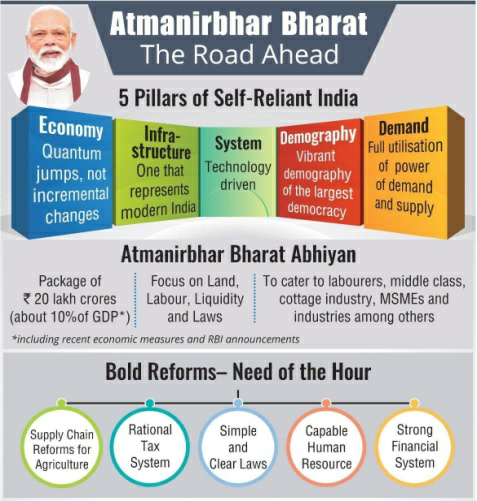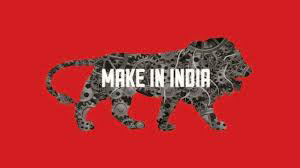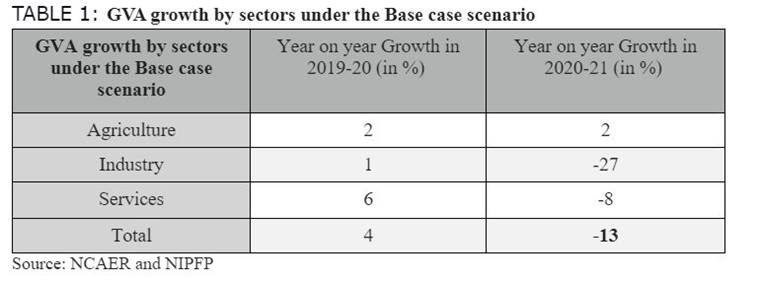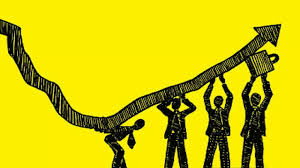In his address to the nation on May 11th, Prime Minister Modi gave a clarion call for ‘Aatmanirbhar Bharat’ which meant establishing a self-reliant Bharat which is not dependent on others for any of its needs. Reminding about his ‘vocal for local’ call, he urged enterprises to make products in India, that can be sold around the world. He concluded his speech by saying “Self-reliant India is about – Strong enterprises; generating employment; empowering people to come out and find solutions, the need is that we make products that are made in India, but made for the world and start cutting our imports”.

The people of India have by now come to expect the announcement of a new program from the government at periodic intervals. Right from Make in India, Swacch Bharat, Less Cash, to this new, ‘Aatmanirbhar’ Bharat campaign, we have always had something larger which has been more like a bigger goal and less like a short term plan. If we try to go back in history, we would know that self-reliance was a stated goal of economic policy in India in the early years after 1947. The architect of this plan was Jawaharlal Nehru, whose record as a Prime Minister especially, economic have trashed relentlessly. However, it is rather simplistic and misinformed to drub Aatma Nirbhar Bharat as the return of socialism and advent of protectionism 2.0.
Under the Aatmanirbhar Bharat Abhiyan, the Government announced a Twenty Lakh Crores stimulus package which is 10 % of India’s GDP to restart the economy and Micro, Small and Medium Companies (MSME’s), Power distribution companies, Non-Banking Financial companies (NBFC’s), Housing Finance Companies and Real Estate Developers formed the central agenda. In his speech, PM Modi also highlighted the five pillars that we need to focus on for making India self-reliant in the 21st century. The five pillars include Economy(moving away from incremental changes with quantum jumps in the economy), Infrastructure(building infrastructure that recognizes modern India), System( technologically driven systems and processes), Demography (vibrant demography of the largest democracy) and Demand( Well functioning demand and supply chains to full capacity).
This post COVID strategy gives a major thrust to agriculture and MSME. Since the first generation reforms, and dwindling prospects in agriculture have succeeded in capping economic growth by containing the overall demand. The government plans to create a unified market in agriculture commodities, pushing investment in agriculture and better price realization for farmers and bringing modern technology in agriculture. The government has also identified animal husbandry and dairying as a sector that can provide livelihoods to millions of rural households. This initiative also expects to complement ‘Make in India’ initiative which intends to encourage manufacturing in India.
Irrespective of all this, the Aatmanirbhar Bharat Campaign is being criticized as people have started questioning its ability to provide economic relief to most distressed sections of the economy or indeed stem the rapid decline in India’s GDP growth.

During the nationwide lockdown, the total quantum of economic activity in the country(measured by monetary values of goods and services) has sharply curtailed. Given an uncertain future for the rest of the year, most observers estimate that the Indian economy will contract. That is, it will produce less in 2020-21 than it did in 2019-20. This means the Gross Value Added (GVA is a proxy for the income earned) across sectors — agriculture, industry, and services — will fall.

If we go for a more in-depth analysis, we observe that the advantages and disadvantages of this campaign are very sector-specific. A lot of data has to be collected for the campaign and it’s an onerous task. In certain sectors, India has a natural advantage but in some specific sectors like the Smartphone and the Automobile Industry, they can take a lot of time before they adjust to any of these changes. In the Indian automotive industry, 27% of automotive components are imports are from other countries (Source – ICRA), which is a majority. Almost all the manufacturers based in India (i.e. having a manufacturing facility in India) irrespective of their origin, have around 8-65% of components coming in from China. If you consider, India’s pharmaceutical industry, it is capable of making finished formulations and also has domestic manufacturers of several key ingredients used to make them, but the industry also imports some key ingredients for antibiotics and vitamins currently not manufactured in India. The country is also currently trying to encourage domestic firms to make these key ingredients, known as fermentation-based APIs. But, this may take a few years. Apart from that, Local dyestuff units in India are also heavily dependent on imports of several raw materials, specialty chemicals for textiles like denim are also imported. The manufacture of some of the key products that India imports such as semiconductors, displays and other very capital intensive electrical equipment may not be possible soon as manufacturing these require large, stable sources of clean water and electricity and they also need a high degree of policy certainty as these require high upfront investments. However, Indian firms can begin producing less sophisticated components, if certain policy measures are taken.
The promise of an Aatmanirbhar Bharat cannot be fulfilled only with long term measures, we would need short term measures to deal with economic grief. Rather than, just long term benefits of easing credit term facilities and a moratorium on loans, the Indian Economy needs short term economic relief as well, and that too in the form of a direct cash infusion.
Also, on the other hand, we would have to understand that Aatmanirbhar Bharat is not exactly about Swadeshi Vs Videshi or being defensive and building protective walls, but embracing the world with pride and confidence. Self-reliance implies reducing dependence on others, but it does not necessarily mean shutting the window to the rest of the world. Capital intensive industries have a large component of imported machinery that is not made in India at this point and some of these countries even have a foreign shareholding. Recently, when the government banned the Chinese apps, a lot of people celebrated and appreciated this move as the first step to being independent of China without even having an idea about the long list of imports from China. According to the Department of Commerce, there are more than 8,000 items imported from China. These items include toothbrushes and toothpaste, pens and nibs, underpants and briefs, tomato seeds, dried onions, green tea, raisins, mango pulp, Kashmir goat hair, waste of human hair, yak tail.. the list is long and endlessly surprising.
For a country that has been dealing with a shaky job market, a perturbing research and development scenario, and is currently facing a radical crisis, an aim for a genuinely Aatmanirbhar Bharat isn’t going to pass muster. Reducing dependence doesn’t mean shutting the window to the outside world when we know that somewhere it is neither possible nor desirable in hyper-connected economies. By placing the palms over our eyes, one can stop seeing the world outside but it does not cease to exist.
The Aatmanirbharta Bharat Abhiyan needs more strategic planning and we need to take one step at a time while India gradually overcomes this economic hibernation. Rather than caving into duplicities, we need to rise above anachronistic ideologies, inefficiency, and petty politics. Maybe by creating the spark for the change that India demands and with greater and equal emphasis on all the sectors, we can translate this idea of Aatmanirbhar Bharat into a reality.

Written by Muskaan
Sources and References :
The Economic Times, The Deccan Chronicle, The Print, The Indian Express, Livemint, The Wire.




